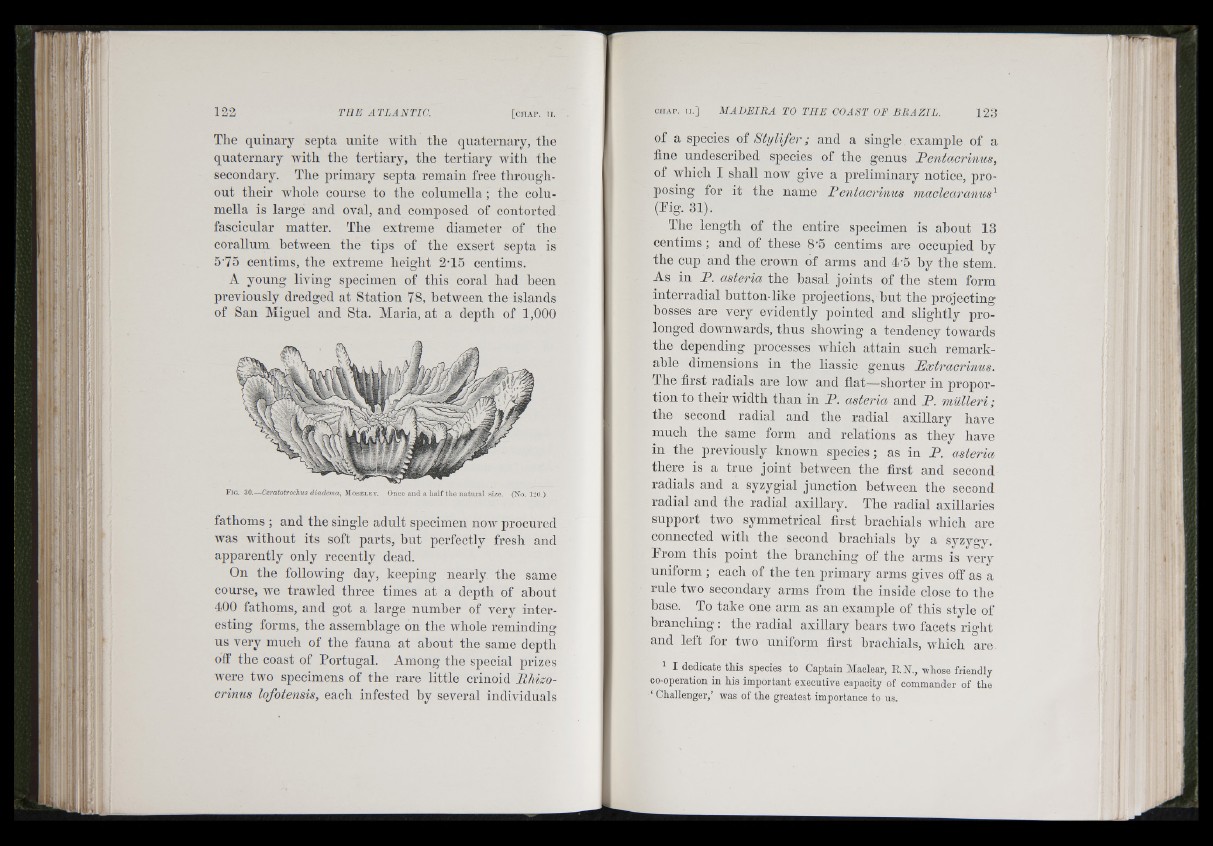
i I i
* 1:i1i1i 'I
The quinary septa unite AA'itli the quaternary, the
quaternary with the tertiary, the tertiary with the
secondary. The primary septa remain free throughout
their whole course to the columella ; the columella
is large and oval, aud composed of contorted
fascicular matter. The extreme diameter of the
corallum between the tips of the exsert septa is
5‘75 centims, the extreme height 2T5 centims.
A young living specimen of this coral had been
previously dredged at Station 78, between the islands
of San Miguel and Sta. Maria, at a depth of 1,000
Fig. so.—Ceratotrochus dia,dema, Moseley. Onec and a half the n atural size. (No. 120.)
fathoms ; and the single adult specimen noAV procured
Avas Avithout its soft parts, but perfectly fresh and
apparently only recently dead.
On the following day, keeping nearly the same
course, Ave traAvled three times at a depth of about
400 fathoms, and got a large number of very interesting
forms, the assemblage on the Avhole reminding
us very much of the fauna at about the same depth
off the coast of Portugal. Among the special prizes
Avere two specimens of the rare little crinoid lihizo-
crinus lofotensis, each infested hy several indiA'iduals
of a species o i S tijlife r ; and a single example of a
fine undescribed species of the genns Pentacrinus,
of Avhich I shall now give a preliminary notice, proposing
for it the name Pentacinnus madearanus^
(Fig. 31).
The length of the entire specimen is about 13
centims ; and of these 8*5 centims are occupied hy
the cup and the croAA'ii of arms and 4*5 hy the stem.
As in P. asteria the basal joints of the stem form
interradial button-like projections, but the projecting
bosses are very evidently pointed and slightly prolonged
dowuAvards, thus showing a tendency towards
the depending processes Avhich attain snch remarkahle
dimensions in the liassic genus Extracrinus.
The first radials are low and flat—shoi“ter in proportion
to their Avidth than in P. asteria and P. mulleri;
the second radial and the radial axillary have
much the same form and relations as they have
in the previously known species; as in P. asteria
there is a true joint hetAveen the first and second
radials and a syzygial junction hetAveen the second
radial and the radial axillary. The radial axillaries
SAipport two symmetrical first brachials Avhich are
connected Avith the second brachials hy a syzyg’v.
From this point the hranching of the arms is very
uniform ; each of the ten primary arms gives off as a
rule tAVO secondary arms from the inside close to the
base. To take one arm as an example of this style of
b ranching: the radial axillary bears tAvo facets right
and left for tAvo uniform first brachials, Avhich are
1 I dedicate tliis species to Captain Maclear, RN ., whose friendly
co-operation in his important executive capacity of commander of the
‘ Challenger,’ was of the greatest importance to us.